Although ume(梅, Prunus mume) is often translated into English as plum, it is more closely related to the apricot. Plum(Prunus salicina) is referred to sumomo(酢桃 or 李) in Japan.
information about ume festivals:
http://www.rurubu.com/season/winter/ume/ (Japanese version only)
http://flower.enjoytokyo.jp/ume/ (Japanese version only)
 |
| Ume matsuri (Plum festival) by pelican /flickr |
Yushima Tenjin Plum(Ume) Festival(湯島天神梅まつり)
Feb.16-March 10
Yushima Tenman-gu Shrine(湯島天満宮), Tokyo
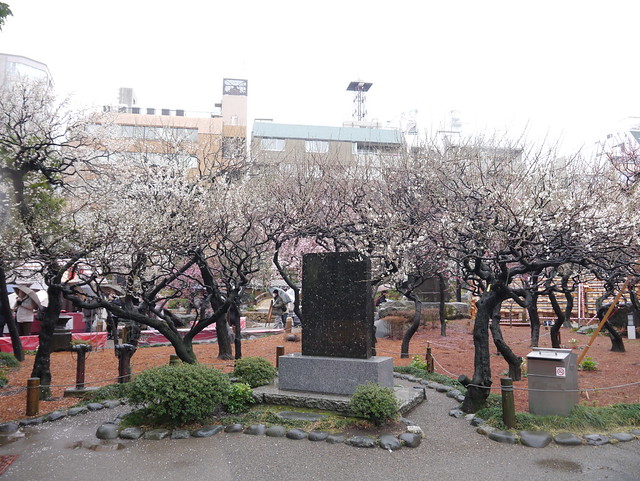 |
| Tokyo : 10 Mar 2012 by chinnian /flickr |
Yoshino Baigo Ume Matsuri (Plum Festival) (吉野梅郷梅祭り)
Feb.23-March 31
Ome City, Tokyo
http://www.omekanko.gr.jp/ume/ (Japanese version only)
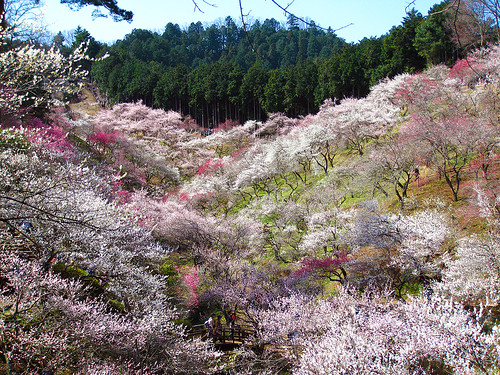 |
| 梅の公園散策 (Yoshino plum grove in Ome) by cyber0515 /flickr |
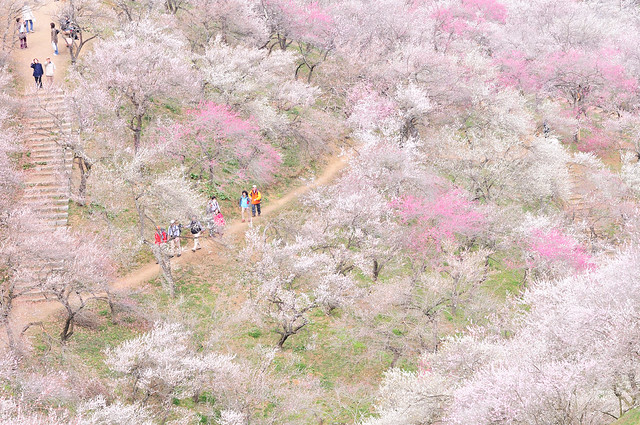 |
| Prunus_15 by ajari /flickr |
Ano bairin(賀名生梅林, Ano ume grove)
Best time to go: late Feb.-late March
Gojo City, Nara Prefecture
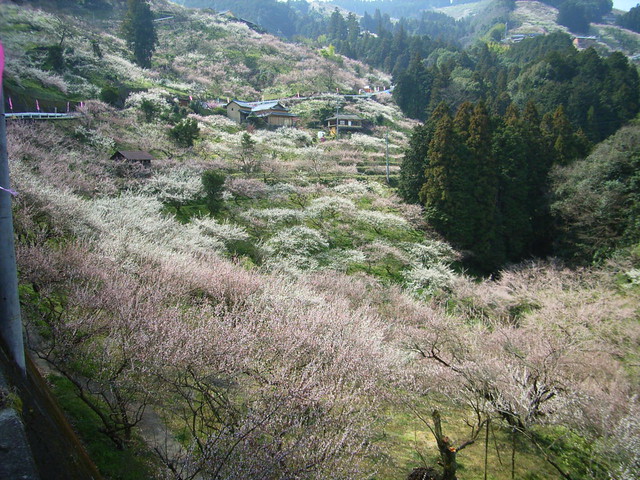 |
| RIMG0017 by Tamago Moffle /flickr |
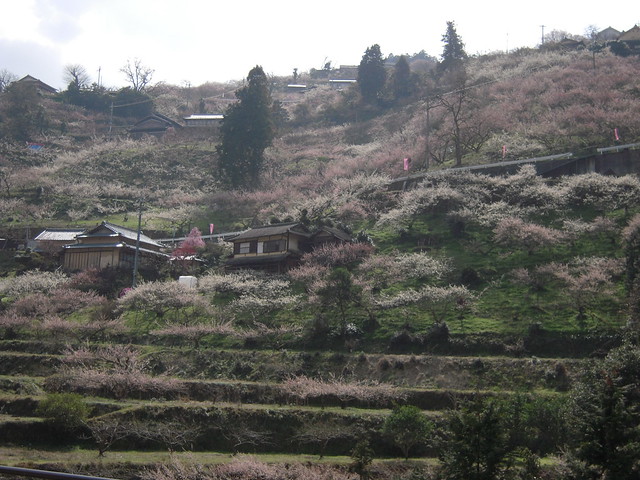 |
| DSCN1717 by Tamago Moffle /flickr |
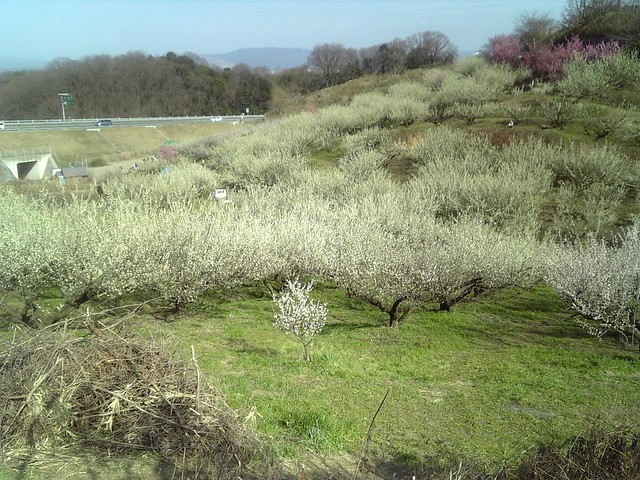 |
| DVC00116 by Tamago Moffle /flickr |
Oiwake Bairin(追分梅林, Oiwake ume grove) is now closed.
Nara City, Nara Prefecture
Osaka Castle Bairin(大阪城梅林) http://www.ocsga.or.jp/osakapark/hfm_park/02osakajo/ume.html#kaika)
 |
| plum grove park(Osaka castle) by tsuda /flickr |
 |
| Osaka by that.girl.possessed /flickr |
Soga Bessho Ume Festival (曽我別所梅まつり)
Feb.2-March 3
Bessho Bairin, Odawara City, Kanagawa Prefecture
Soga Bairin(曽我梅林) is a generic term that includes the three (Nakagawara Bairin(中河原梅林), Hara Bairin(原梅林) and Bessho Bairin(別所梅林)) ume groves.
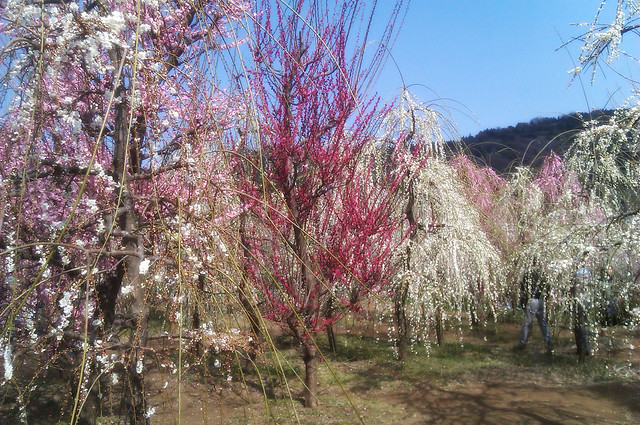 |
plum garden in Soga, Kanagawa by Y.Fujii /flickr
|
Many ume trees were planted in order to secure ume fruits as army provisions over 600 years ago. Odawara is a town that was a resting spot along the Tokaido road in the Edo period.
Umeboshi(pickled ume fruits) quench thirst, relieve fatigue, and prevent decay. They were popular among travelers, and travelers placed them in box lunches.
Umeboshi is made by pickling ripe ume fruits in salt with red shiso leaves, drying them in the sun. My home-made umeboshi is ready. After that, some people soak them again in the vinegar from the fruits.
ume fruits for umeboshi
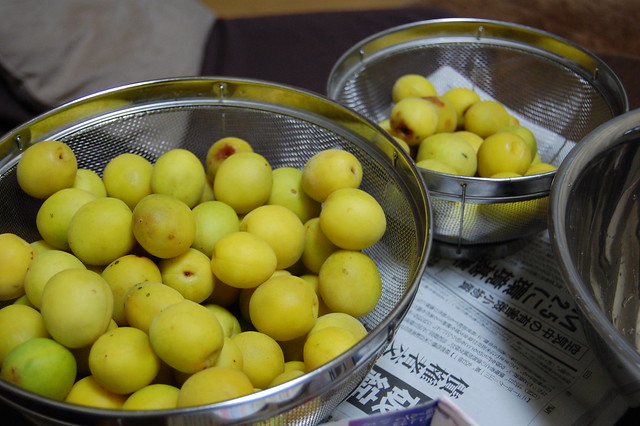 |
| 梅仕事2009 (1) by salchu /flickr |
umeboshi
 |
| 梅干し by HIRAOKA,Yasunobu /flickr |
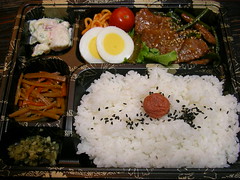 |
| Bento@06.08.07 / jetalone /flickr |
a box lunch with a umeboshi in the center of rice
 |
| A plum liqueur. by skyseeker /flickr |
Umeshu is a liqueur made by soaking unripe ume fruits in crystal sugar and Shochu(Japanese distilled liquor).
Ume no Utage(梅の宴)
Feb.9-March 10
Yugawara bairin, Makuyama Park(幕山公園), Yugawara-cho, Kanagawa Prefecture
 |
| makuyama park by jessleecuizon /flickr |
Ume Garden at Koishikawa Korakuen Garden (小石川後楽園), Tokyo
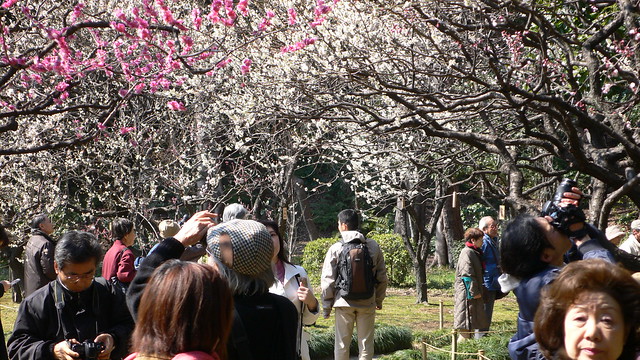 |
| 小石川後楽園梅園 by Masashige MOTOE /flickr |
Ume Festival(梅まつり)
Feb.20-March 31
Kairaku-en(偕楽園), Mito City, Ibaraki Prefecture
 |
| kairakuen by vera46 /flickr |
 |
| kairakuen by vera46 /flickr |
"plum ambassador" girls
Ume Garden(梅苑) at Kitano Tenmangu Shrine(北野天満宮), Kyoto
Feb.9-late March
 |
| Kitano Tenmangu by JoshBerglund19 /flickr |
 |
| Plum Garden by mrhayata /flickr |
Kyoto Gyoen National Garden(京都御苑)
Nagahama Bonbai Exhibition (長浜盆梅展)
Jan.19-March 10
Keiun-kan(慶雲館), Nagahama City, Shiga Prefecture
Bonbai means ume tree bonsai. This event was derived from about 40 ume bonsai that a bonsai lover donated to Nagahama City in 1951. He collected old ume trees growing in the mountains. After potting them, he trained them into bonsai for years. Potting old trees is said to be very difficult. This event started in 1952.
About 90 bonsai trees are open to the public.
Now some bonsai experts take care of these bonsai trees. They also collect old ume trees, potting them and trained them into bonsai for 10 to 20 years. After training for years, ume trees make their debut as bonsai at this event every year.
Keiun-kan Guest House(慶雲館) was built as a temporary palace for Meiji Emperor on a tour in 1887. Its circuit style garden created by Jihei Ogawa is designated as a national scenic beauty. Usually, the house is open to the public from March 24th to November 30th.
 |
| Plum bonsai by MShades /flickr |
Furo(不老, eternal youth), far right, is about 400-year-old ume tree with double red flowers. It is 2.5 meters high and 1.8 meters around.
This event shows other old ume trees such as Shoryubai(昇龍梅, rising dragon), Sazareiwa(さざれ岩).
Shoryubai is about 250-year-old ume tree with single white flowers. It is 1.9 meters high and 1.0 meter around.
Sazareiwa is about 350-year-old ume tree with double rose-pink flowers. It is 2.8 meters high and 1.6 meters around. Sazareiwa (or Sazareishi) means limestone breccia.
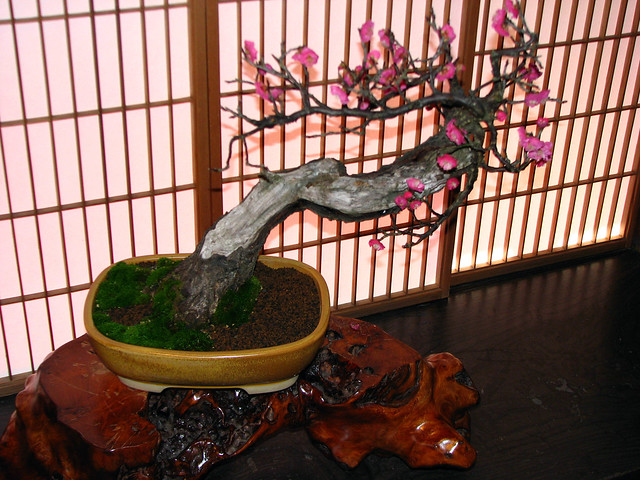 |
| Plum bonsai by MShades /flickr |
 |
| Plum bonsai by MShades /flickr |
Bonsai trees by individual lovers are also exhibited.
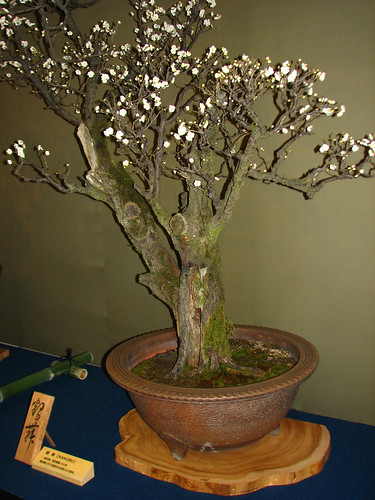 |
| Plum bonsai by MShades /flickr |
Kakubu(鶴舞, crane dance) is about 150-year-old ume tree.
 |
| Plum bonsai by MShades /flickr |
Shirosudare(白簾) is called from its resemblance to a curtain made of strung white beads.
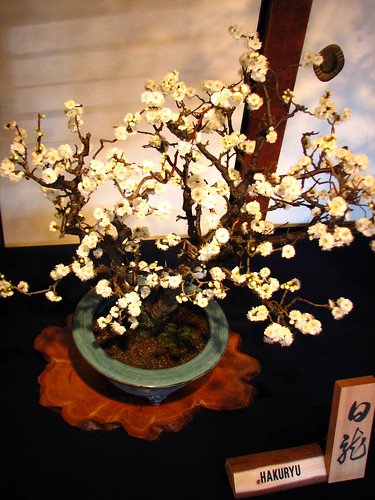 |
| Plum bonsai by MShades /flickr |
Hakuryu(白龍, white dragon)
 |
| Plum bonsai by MShades /flickr |
 |
| Plum bonsai by MShades /flickr |
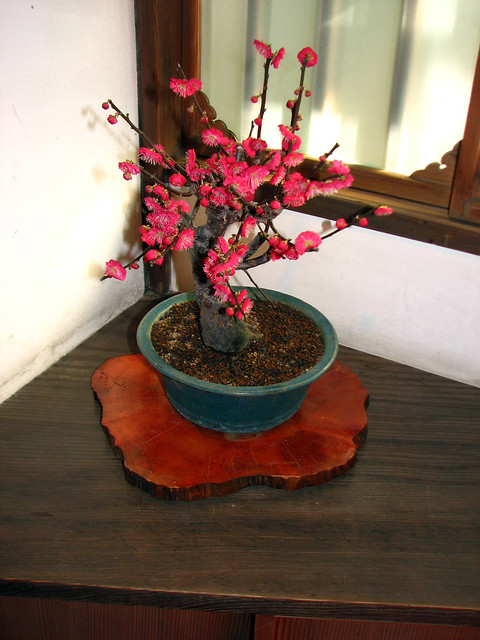 |
| Plum bonsai by MShades /flickr |
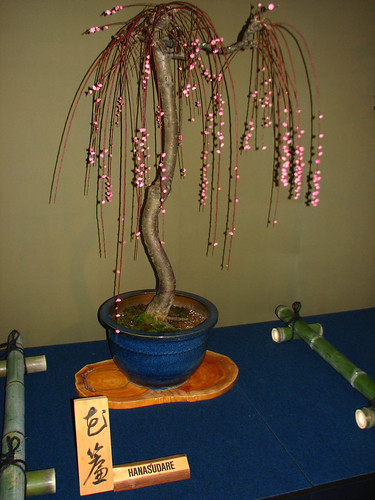 |
| Plum bonsai by MShades /flickr |
Hanasudare(花簾) is called from its resemblance to a curtain made of strung beads.
Anpachi Ume Festival(安八梅まつり)
Feb.17-March 17
Anpachi Hyakubaien Park(安八百梅園), Anpachi-gun, Gifu Prefecture
performances of koto at Anpachi Bonbai Exhibition
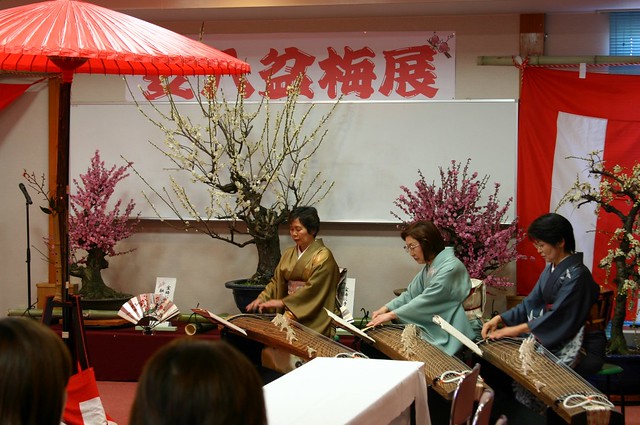 |
| IMG_8679 by shail05 /flickr |
things related to ume
 |
| umegae moti by moon angel /flickr |
Umegae-mochi(梅が枝餅) is a rice cake filled with sweet bean paste and a ume design is stamped on top. Its name is derived from an episode of Sugawara Michizane.
Umegae-mochi is sold in Dazaifu City, Fukuoka Prefecture.
Legend has it that the ume blossoms in his garden followed him to Dazaifu in the air.
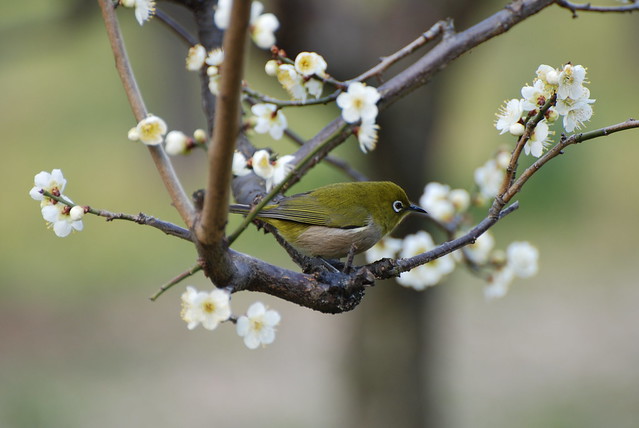 |
| Japanese White-eye by kuribo /flickr |
Ume and a white-eye
Maiko wear kanzashi decorated with silk ume blossoms in February.
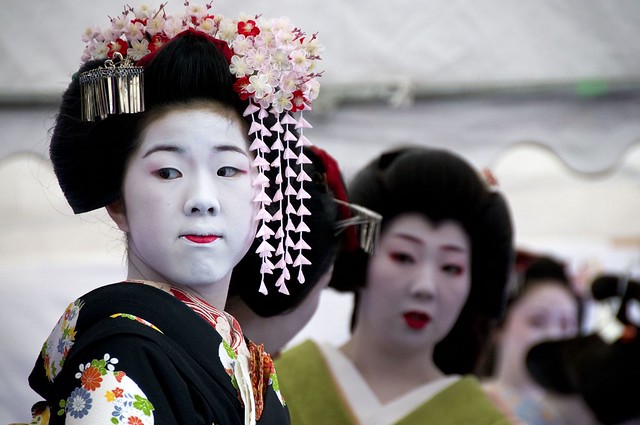 |
| Kitanotenmangu maiko by flackblag7 /flickr |

























